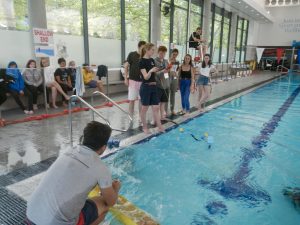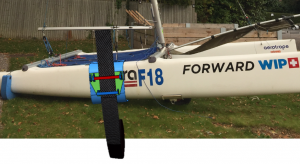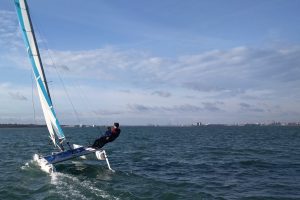The “Future Marine Engineering” is an exciting residential course, developed to inspire Year 9 students aged 13 to 14 about marine engineering and career opportunities in the maritime sector. The course was organised by the Smallpeice Trust with technical content delivered our own inspiring team of post-doctoral researchers, Dr Jeanne Blanchard, Mr Przemyslaw Grudniewski and Dr Yikun Wang, in the Fluid Structure Interactions group at the University of Southampton.

This year, 95 students took part in the 3.5 days course with the aim to design and build a wave energy-harvesting device and a remote control boat to simulate a maintenance vessel for their renewable energy farms. The objective was to provide a prototype design to generate as much power from the wave energy-harvesting device as possible and to develop a maintenance vessel that could quickly and reliably service the energy farms in an emergency. The students were given a limited quantity of materials to design, build and test their products with their unlimited imaginations. In addition, they were to perform a “Dragon’s Den” style pitch and to defend their designs against rigorous technical ‘interrogations’ from some marine experts.

To help the students develop their understanding of the marine industry they were given different talks by academics and an industrial expert from Shell Shipping and Maritime. This culminated in a celebration of their achievements at a formal dinner and an opportunity for the students to present their projects to academics and Seafarers UK, who kindly sponsored the course. On the last day, the students have tested their devices and model boats in the swimming pool with great success, before attending the awards ceremony with prizes given by Southampton Marine and Maritime Institute and the Royal Institution of Naval Architects with the chance for the students to join the Institution as junior members.
Tag Archives: sailing
GDP 23: Hydrofoiling Catamaran Experimental Research Platform
In recent years there has been an increasing trend of utilising hydrofoils to reduce drag and enhance the performance of high speed sailing vessels, following the developments of the International Moth class and the AC72s in the 34th America’s Cup. With this current interest growing within the marine industry, it is an exciting opportunity to establish a research platform acting as an interface to effectively carry out experimental testing of innovative hydrofoil technology.

Our aim is to create this research platform by retrofitting a NACRA F18 catamaran using two J-shaped foils to facilitate foiling. In addition, two T-foil rudders will be designed and manufactured from composite materials. A pod system inserted onto the existing daggerboard cases, seen in Fig. 1, will also be developed to attach the J-foils to the side of the boat. The rudders will be designed to have interchangeable wings, allowing for different combinations of main foils and rudder tips to be used. This will permit the investigation into effects of alternative designs. These are the two main features that affect the forces acting on the boat and are therefore very important when developing a foiling craft.

In order to analyse the boat’s response to real world conditions and to collect performance data such as speed, acceleration, roll, rate of turn and foils force, a suitable data acquisition system will also be developed. We aim to provide a good basis for further hydrofoil research to be carried out within the University and hope to encourage more curious minds to pursue naval architecture!

If you want to find out more about the project as it goes forward please visit their facebook page https://www.facebook.com/TheVolantiProject/
